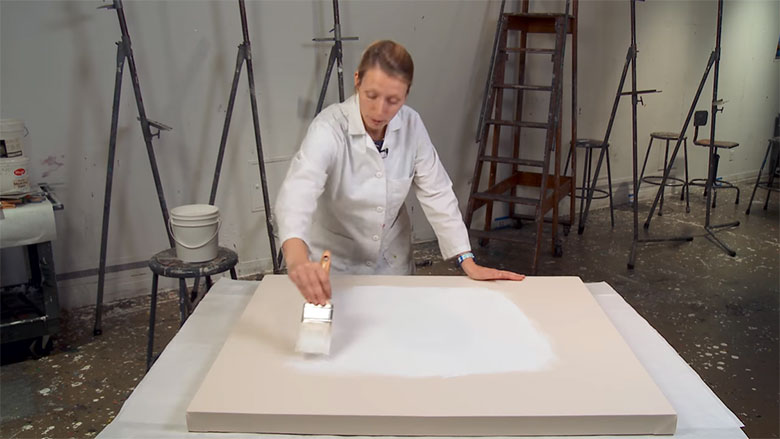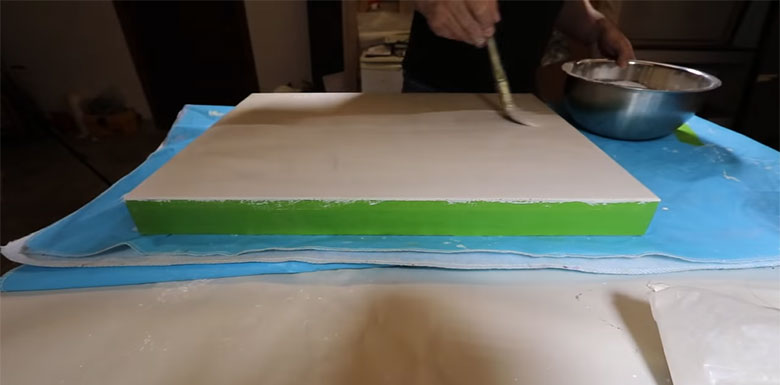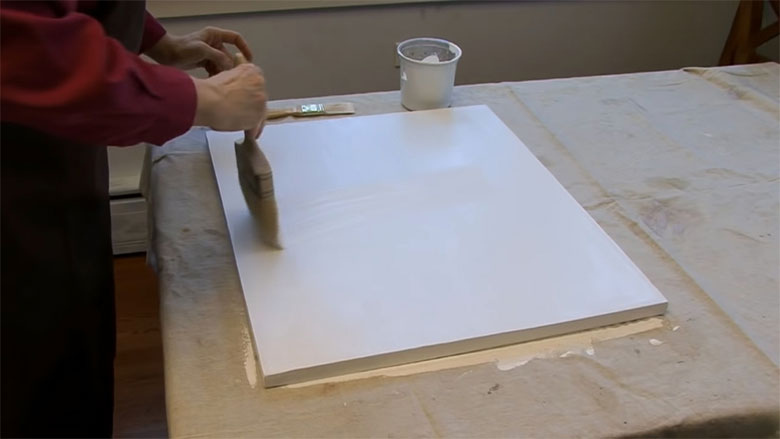If you’re planning to paint a raw canvas with oils or acrylics… STOP!
Before you start painting that surface you have to complete one very important step: priming the canvas. This step will prevent your paints from soaking into the canvas fibers. Without it your piece will have dull patches from the paint soaking in.
Below, you’ll discover 3 brush patterns for priming your canvas, and learn how to prime your canvas with 3 different priming mediums: acrylic gesso, traditional primers, and casein gesso.
3 Ways To Prime Your Canvas
There isn’t just one right way to apply your primer – you can work from the center out, the edges in, or parallel strokes. The goal is simply to create a very smooth surface with a bit of tooth (small ridges for the paint to stick to). Even if the canvas you bought was “pre-primed” it’s best to prime it again to ensure you have good quality primer laid down.
1. Center Out
One way to prime is from the center out, like the sun emitting its bright rays. I like to start by putting a little primer right in the middle and rotating the canvas in a circle, painting my primer outward.

2. Start Out, Work In
You can also start by coating the edges, then pull the primer inward. One downside to this method is that you cover the edges first – which can be useful to grab to reposition the canvas as you go.
3. Painting In Different Directions With Each Coat
Yet another method is painting in parallel strokes from top to bottom. Once that coat dries, you can add a second layer that’s perpendicular to the first. To see this method in action, watch this artist:
Types Of Canvas Primer
There are a few options you can choose from for oil color priming or acrylic color priming. In this post, we’ll focus on three that are suitable for painting with both acrylic and oils.
Modern day options like acrylic and casein primers are very similar to white acrylic paint. They’re easy to apply, dry quickly, and can be used as oil or acrylic primers. However, if you prefer more work, you can use the traditional options instead. Let’s look at how to apply each.

Applying Acrylic Gesso
Acrylic primer, also known as Gesso, is an excellent choice for acrylic and oil paintings and requires very few steps compared to the two other options we’ll discuss in this post.
Acrylic primers dry quickly and you only need about 15 minutes between coats. But you should wait at least one hour before painting – preferably 24.
What you need:
- Wide brush
- Acrylic gesso
- Drop cloth
- Water
- Fine sandpaper
1. Prep Your Space And Prime
Lay down your drop cloth, shake your Gesso thoroughly, and grab your canvas. You can either pour a little Gesso directly on the canvas, or onto a plate/palette. Dip your brush in water, remove the excess, and spread your Gesso using one of the above brush methods.

2. Let It Dry And Go Back For Round Two
Let the first layer dry, then gently sand it for a smoother surface. Then, apply your second coat… or third or fourth. However much it takes to create an opaque white primed surface.
You can see an artist priming a canvas in this video:
Applying Traditional Primer
You’re in for quite a lengthy process if you choose to use traditional primer. I recommend doing more than one canvas board at a time for maximum efficiency.
These very old style primers are made of rabbit skin glue mixed with “whiting” (chalk) to improve the surface’s absorbency. And before you apply them, you have to size your canvas (paint it with animal glue).

Traditional primer also has to be used on a rigid support like a canvas panel, not a stretched canvas on a frame. It must be applied while warm, requiring 5-15 coats, which should all be sanded to create a smooth surface.
What you’ll need:
-
- Traditional Primer
- Rabbit skin glue or PVA (polyvinyl acetate)
- Pot for heating rabbit skin glue
- 2 bowls
- Decorator’s brush
- Fine grit sandpaper

1. Lay Down Your Drop Cloth And Start Sizing
Prepare your size (animal hide glue) as per the instructions on the package. You’ll likely need water, a pot, a stovetop to heat it up to about 135 degrees, and a bowl to pour it into.
Once the liquid is heated, place your canvas on a drop cloth and paint one or two coats of sizing onto your canvas boards. Let them dry for 24 hours.
2. Prep Your Primer
Once they’re dry, grab your traditional priming powder and prepare it as described in the instructions. Some forms require mixing powder into hot water, then applying immediately.
Others instruct you to let it gel for 2 hours, then heat it to create a liquid. Double-check to see which you have.

3. Prime Your Canvas Boards
Apply your primer with a decorator’s brush in parallel vertical strokes. It’s ok if the first layer is very thin. Traditional primer needs several coats before the primed surface becomes opaque white primer.

4. Dry And Lightly Sand
Let the coat dry completely, then lightly sand it to even out any brush strokes.
5. Prime And Repeat
Repeat steps 3 and 4, switching between vertical and horizontal strokes with each coat. Voila, you have a canvas that’s ready for oil colour or acrylic colours.
To watch the process in action check out this video:
Applying Casein Gesso
Casein primer is much like a traditional primer without the complicated mixing. It can be applied right out of the jar and can be used for oil or acrylic color priming.
What you need:
- Wide brush
- Casein gesso
- Drop cloth
- Water
- Fine grit sandpaper

1. Apply The First Layer
Once sized, casein is suitable for both acrylic and oil paint primer.
Lay out your drop cloth, shake your casein primer, then get your canvas. You can pour a little Gesso directly on the canvas or a plate/palette. Dip your brush in water, remove the excess, and spread the primer.

2. Let It Dry And Apply The Next Coat
Let layer one dry, then apply your second coat.
Clean your brush, cap your casein, and come back tomorrow. You can apply as many coats as you want, but only 2 per day since the emulsified oils have to cure.

3. Apply Your Final Coat, Then Cure
Once you’re satisfied with your coverage, let it cure for a week.
The Importance of Primer
Without primer, your pigments will soak into your stretched canvas and allow the white of the fibers to show through.
Primers add rigidity to your piece, create a smoother surface that evens out your paints, and gives them a solid foundation to “grab” onto.
By priming your canvas, you save yourself the hassle of wasting paint, trying to cover a surface that just won’t stop absorbing.
Check out our favorite oil paint primers if you are an oil painter. Alternatively, you can read our review of the best brands of gesso.



